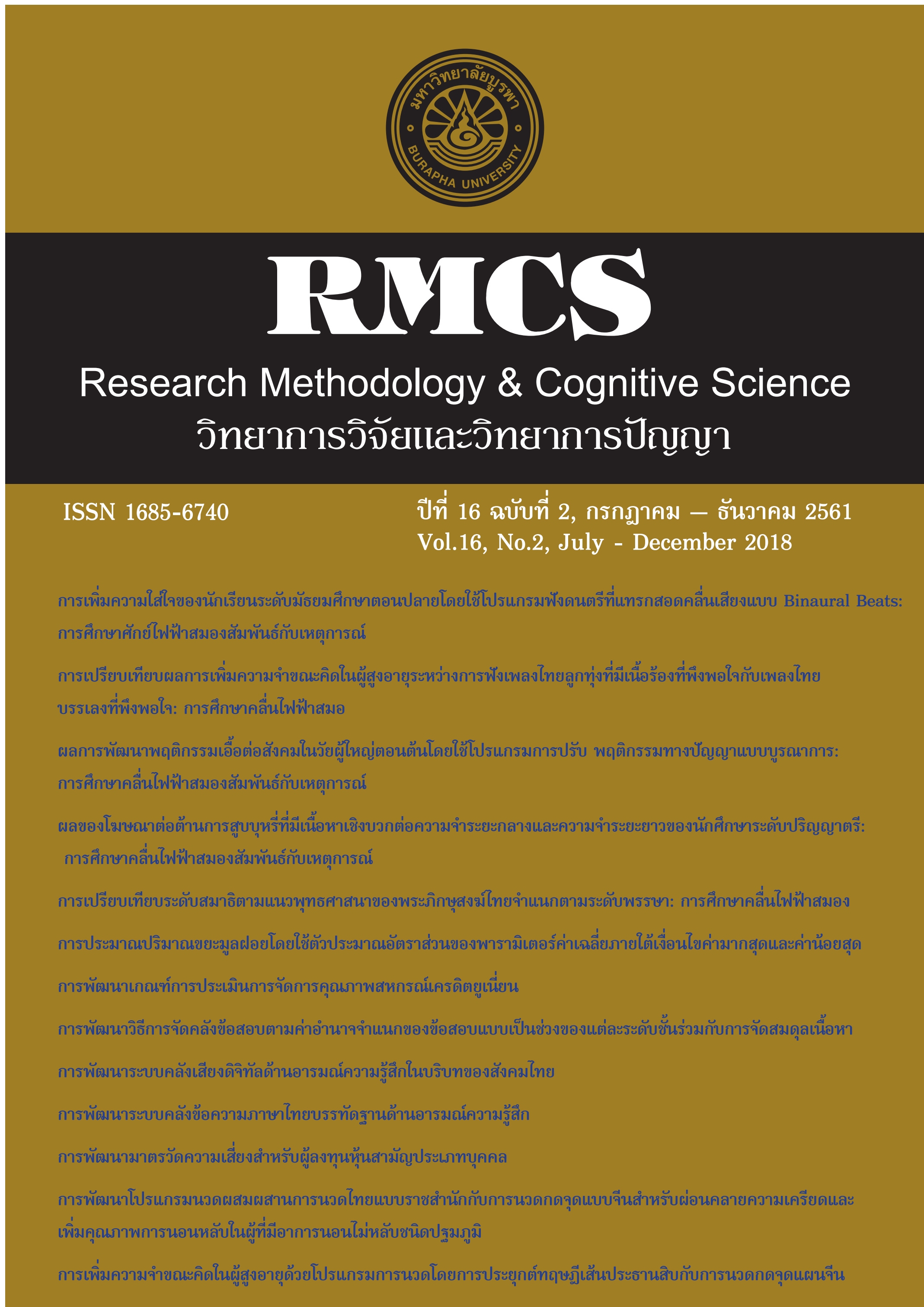Development of the Affective Digitized Bank System in Thai Society
Main Article Content
Abstract
Sounds are important stimuli for transferring meaning, understanding of situations, or better interpretation of events. Therefore, it can be concluded that sounds are stimuli which convey human emotion. The objectives of this research were to analyze the affective digital sounds in context of Thai society; and to assess the quality of the affective sounds in terms of content validity, discrimination index, mean and standard deviation of each sounds. The reliability of Thai sounds composed of three emotional domains, i.e. valence, arousal, and dominance. Additionally, the computerized affective sound bank system in Thai context was developed. The research sample was 400 Thai volunteers with normal hearing who lived in Thailand and aged between 18 and 60, with regardless of gender, educational level, and marital status. They were derived by convenient sampling. The Self-Assessment Manikin Scale were employed in the study, and t-tests were used to analyze the data.
The research results were:
- There were 657 Thai affective digitized sounds in Thai society context, compiled and passed the consideration of the 6 experts.
- There were a total of 594 Thai affective sounds were validated. These sounds were classified into three emotional dimensions: 1) 170 valence sounds (45 pleasant, 63 neutral, and 61 unpleasant), 2) 212 arousal sounds (148 exciting, 46 neutral, and 18 calm), and 3) 212 dominance words (37 afraid, 85 neutral, and 90 unafraid).
- Regarding the development of the Thai affective digitized sound bank system, it was produced as an online web application. Quality testing of the bank was assessed by computer experts and users and judged to be of a good standard.
Article Details
References
ธวัชชัย ศรีพรงาม, เสรี ชัดแช้ม และสมพร สุทัศนีย. (2558). การพัฒนาระบบคลังรูปภาพที่สื่อความหมายทางด้านอารมณ์ความรู้สึกในบริบทของคนไทย. วิทยาการวิจัยและวิทยาการปญญา, 13(2), 57-70.
สุชีรา ภัทรายุตวรรตน์. (2556). คู่มือการวัดทางจิตวิทยา (Manual of Psychological Testing). (พิมพ์ครั้งที่ 5). กรุงเทพฯ: เมดิคัล มีเดีย.
โสฬส สุขานนท์สวัสดิ์, เสรี ชัดแช้ม และกฤษณะ ชินสาร. (2555). การพัฒนาวิธีการคัดเลือกข้อสอบข้อถัดไปโดยใช้ทฤษฎีการตัดสินใจในการทดสอบแบบปรับเหมาะด้วยคอมพิวเตอร์. วิทยาการวิจัยและวิทยาการปญญา, 10(2), 71-85.
อภิชัย มงคล, ยงยุทธ์ วงศ์ภิรมย์ศานติ์, ทวี ตั้งเสรี, วัชนี หัตถพนม, ไพรวัลย์ ร่มซ้าย และวรวรรณ จุฑา. (2552). รายงานการวิจัย การพัฒนาและทดสอบดัชนีชี้วัดสุขภาพจิตคนไทย (Version 2007): กรมสุขภาพจิต กระทรวงสาธารณสุข. กรุงเทพฯ: โรงพิมพ์ชุมนุมสหกรณ์การเกษตรแห่งประเทศไทย.
อรยา ปรีชาพานิช. (2558). คู่มือเรียนการวิเคราะห์และออกแบบระบบ (ฉบับสมบูรณ์). นนทบุรี: ไอดีซี พรีเมียร์.
Anastasi, A. (1988). Psychological Testing. New York: Macmillan.
Best, J. W. (1977). Research in Education. New Delhi: Prentice Hall of India.
Bradley, M. M., & Lang, P. J. (1994). Measuring emotion: The self-assessment manikin and the semantic differential. Journal of Behavior Therapy and Experimental Psychiatry, 25(1), 49-59.
Bradley, M. M., & Lang, P. J. (1999). The International Affective Digitized Sounds (IADS): stimuli, instruction manual and affective ratings: NIMH Center for the Study of Emotion and Attention.
Bradley, M. M., & Lang, P. J. (2007). The International Affective Digitized Sounds (2nd Edition; IADS-2): Affective ratings of sounds and instruction manual. Tech. Rep. B-3. Gainesville, FL: University of Florida.
Choi, Y., Lee, S., Choi, I.-M., Jung, S., Park, Y.-K., & Kim, C. (2015). International Affective Digitized Sounds in Korea: A Cross-Cultural Adaptation and Validation Study. Acta Acustica united with Acustica, 101(1), 134-144.
Choi, Y., Lee, S., Jung, S., Choi, I.-M., Park, Y.-K., & Kim, C. (2015). Development of an auditory emotion recognition function using psychoacoustic parameters based on the International Affective Digitized Sounds. Behavior Research Methods, 47(4), 1076-1084.
Cureton, E. E. (1998). Simplified formulas for item analysis. Journal of Educational Measurement, 3(2), 187-189.
Hair, J. F., Jr., Black, W. C., Babin, B. J., Anderson, R. E., & Tatham, R. L. (2014). Multivariate data analysis (6 ed.). Upper Saddle River, New Jersey: Prentice Hall.
Lopez, A. T. (1998). The item discrimination index: Does it work. Rasch Measurement Transactions, 12(1), 626.
Mehrabian, A., & Russell, J. A. (1974). The basic emotional impact of environments. Perceptual and Motor Skills, 38(1), 283-301.
Montefinese, M., Ambrosini, E., Fairfield, B., & Mammarella, N. (2014). The adaptation of the affective norms for english words (ANEW) for italian. Behavior Research Methods, 46(3), 887-903.
Murphy, D. (2005). Psychological testing: principles and applications: Pearson/Prentice Hall.
Nunnally, J. C. (1978). Psychometric theory. (2nd ed.). New York: McGraw-Hill.
Osgood, C. E., Suci, G. J., & Tannenbaum, P.H. (1957). The Measurement of Meaning. Illnois: Urbana of Illnois Press.
Rajagopalan, S. (2014). Review of the myths on original software development model. International Journal of Software Engineering & Applications, 5(6), 103-111.
Redondo, J., Fraga, I., Padrón, I., & Piñeiro, A. (2008). Affective ratings of sound stimuli. Behavior Research Methods, 40(3), 784-790.
Singh, D., Thakur, A., & Chaudhary, A. (2015). A Comparative Study between Waterfall and Incremental Software Development Life Cycle Model. International Journal of Emerging Trends in Science and Technology, 2(04), 2202-2208.
Soares, A. P., Pinheiro, A. P., Costa, A., Frade, C. S., Comesaña, M., & Pureza, R. (2013). Affective auditory stimuli: Adaptation of the international affective digitized sounds (IADS-2) for European Portuguese. Behavior Research Methods, 45(4), 1168-1181.
Stadthagen-Gonzalez, H., Imbault, C., Sánchez, M. A. P., & Brysbaert, M. (2017). Norms of valence and arousal for 14,031 Spanish words. Behavior Research Methods, 49(1), 111-123.
Wundt, W. M. (1896). Lectures on human and animal psychology: S. Sonnenschein.
Yang, W., Makita, K., Nakao, T., et al. (2018). Affective auditory stimulus database: An expanded version of the International Affective Digitized Sounds (IADS-E). Behavior Research Methods. 1–15.

